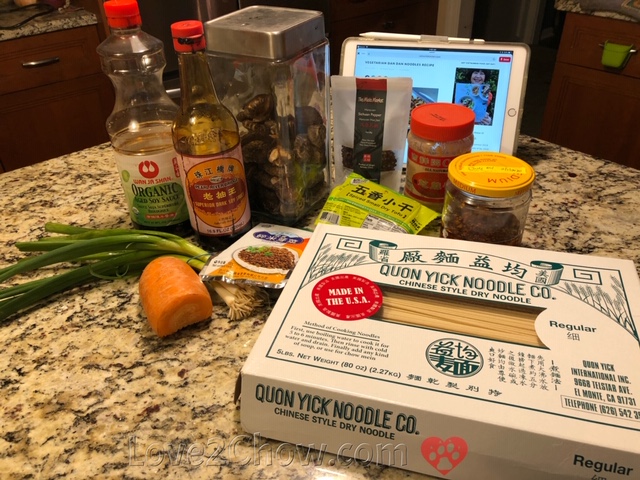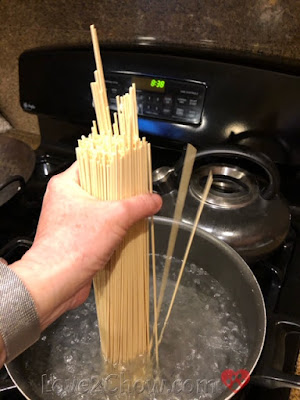A classic Chinese street food, dan dan noodles 擔擔面 are supremely satisfying and easy to assemble with make-ahead components. Named for the long pole used to balance a pot of noodles and a pot of sauce across a street vendor's shoulders, this Szechuan dish is typically topped with ground pork richly flavored with pickled mustard green stems. Due to canceled vacation travel and a challenge by my daughter, I had time at home to perfect a delicious vegetarian dan dan noodle that is also visually and texturally satisfying.
 |
| Vegetarian Dan Dan noodles with vegan topping (recipe below), but using egg noodles |
 |
| Pork dan dan noodles, traditional recipe from Land of Plenty. |
Over the years, I have tried both of the recipes in Land of Plenty by Fuschia Dunlop, Cecilia Chang's recipe in The Seventh Daughter, and Diana Kuan's recipe from the Appetite for China website. I also tried Andrea Nyugen's vegetarian recipe, which uses my favorite dried noodles made by the Quon Yick Noodle company. I am intrigued by the Woks of Life recipe, which adds fresh Chinese greens, but have not yet had a chance to try it.
 |
| Pork dan dan noodle, recipe from the Appetite for China website. |
Dan dan noodles consists of 3 main components: the Sauce, the Noodles, the Topping, and some optional garnishes. It can be pre-mixed and served family style, but is also perfect for self-assembly in a noodle bar format. This makes it easy to accommodate those that love or hate pork, turkey, or beef. As discussed below, it is also easily adapted for vegetarian, vegan and even gluten-free guests.
The Sauce.
The basic flavor elements of the sauce arise from soy sauce, black vinegar, chili oil and Sichuan peppercorns, which add salty umami, sour-sweet, spicy and numbing qualities. In some versions, sesame paste may be added or substituted for the Sichuan peppercorns, changing the flavor and texture profile. |
Xie laoban's beef dandan noodles with sesame paste from Land of Plenty.
|
 |
| Chinese sesame sauce, sesame paste or sesame butter. |
 |
| The traditional sauce from Dunlop, which does not have sesame paste |
 |
| The thickest Nyugen sauce and thinner Kuan sauce made using water instead of chicken broth. |
 |
| Separated oil and solids need a bit of work to get blended into a thick, smooth paste |
The Noodles.
 |
| Dan dan noodle recipe from The Seventh Daughter, using medium thickness fresh frozen egg noodles |
 |
| Ingredients for vegetarian dan dan noodles |
 |
| Quon Yick dried noodles take only about 4 minutes to cook (3 if you will be panfrying them after boiling) |
The Traditional Topping with Meat
 |
| Dark, flavorful bits of suimiyacai pickled mustard green stems are used to season ground meats, with optional ginger/garlic. |
Developing a Vegan Topping
My daughter recently challenged me to adapt some of our favorite dishes to a vegetarian diet, and to try eating vegetarian for 2 weeks. Given that I sometimes omit the meat altogether for convenience, relying upon the suimiyacai to add a depth of flavor to my shortcut Szechuan dry-fried green beans, I knew this pickled vegetable had to remain as part of my vegetarian Szechuan master mix. To add protein, I chopped up some dry tofu, a pressed and marinated form of tofu that is meaty in texture instead of being soft like regular tofu. For years growing up, dry tofu and tofu skins (yuba) were the only forms of tofu that I liked. |
| Dry tofu, seasoned with a firm texture, is the easiest tofu to introduce (See also my blog post on enjoying tofu) |
While the water was heating, I dry toasted the Szechuan peppercorns and a single dried red "facing heaven" chili as my daughter prefers mild food. This quickly became fragrant and I added some oil for cooking the carrot, dry tofu, mushroom mixture. When the carrots were cooked, but still crisp, I added the suimiyacai, ginger and garlic.
What a beautiful topping! The sauce ingredients were mixed and divided among 4 bowls. As soon as the noodles were cooked and drained, they were added to the bowls, topped with the tofu-mushroom-carrot-yacai mixture, and garnished with bright green scallions and/or cilantro.
This vegetarian version of dan dan noodles blew me away! The topping was fully satisfying with its different textures, colors and flavors played out against the smooth noodles with their thin coating of tart-salty-spicy sauce.
Love2Chow Dan Dan Noodles with Two Toppings
Making the toppings in advance as a Master Mix simplifies the preparation to mixing the sauce, cooking the noodles and chopping garnishes.
Ingredients for 4 servings
Vegetarian Topping
4 dried Chinese mushrooms (dried shiitakes), soaked in water for at least 1 h
4 oz (w) of dry tofu
1 oz raw carrot
2 tsp soy sauce (or 1/2 Tbs regular and 1/2 tsp dark soy sauce)
2 Tbs suimiyacai
1/2 tsp Szechuan peppercorns
1-3 dry red chilis, such as "facing heaven" chilis
OR
Meat Topping
1/2 tsp Szechuan peppercorns
1-3 dry red chilis, such as "facing heaven" chilis available from Mala Market or Penzeys
1/4 to 1/3 of a recipe of Szechuan Master Meat Mix
(or stir-fry 4-6 oz (w) raw ground meat + 1-2 tsp each of suimiyacai, minced garlic and minced ginger in a hot pan with a little oil)
Sauce
3 Tbs soy sauce (or 2 Tbs regular and 1 Tbs dark soy sauce)
1 Tbs sesame paste, with oil mixed back in
2 Tbs Chinkiang (black) or balsamic vinegar
1-3 Tbs chili oil including resuspended chili flake sediment
1 Tbs sesame oil
2 tsp sugar
1/2 cup water
Noodles and garnishes
1 pound fresh or frozen Chinese egg noodles or 8-10 oz dry Chinese noodles
Chopped scallion and/or cilantro
Chopped peanuts (optional)
1.1. For the vegetarian topping:
b. Marinate the mushroom, dry tofu and carrots in the soy sauce with optional garlic and ginger. If you have it, dark soy adds a rich color.
c. Measure out the suimiyacai and Szechuan peppercorns. Cut the dry chilis into 2-3 pieces. Prepare the sauce while topping marinates.
d. Heat a wok, cast iron or heavy stainless steel pan over medium heat. Dry toast the Szechuan peppercorns and red chilis for about 30 sec or until it is fragrant (be careful not to burn them)
e. Stir in a Tbs of neutral cooking oil, turn up the heat to medium-high, and add optional garlic and ginger. After 10-15 s, add the marinated tofu mixture. Stir fry for 1-2 minutes and then add the suimiyacai, tossing until the mixture is hot. Remove from heat and set aside.
1.2. For the meat topping:
a. Heat a wok, cast iron or heavy stainless steel pan over medium heat. Dry toast the Szechuan peppercorns and red chilis for about 30 sec or until it is fragrant (be careful not to burn them)
b. Turn up the heat to medium-high, and add the Szechuan Master Meat Mix, tossing until the mixture is hot (or add some oil and cook the ground meat with the suimiyacai, garlic & ginger). Remove from heat and set aside.
Toppings can be made in advance. Re-warm, if necessary, while noodles are cooking
3. Cook the noodles per package directions. Generally, the fresh noodles are done in 3 minutes after returning to a boil, the Quon Yick noodles are done in 4-5 minutes, while spaghetti takes longer. Check by taking a taste of the noodle before removing from the hot water.
4. To serve family style, add drained noodles to the sauce, and toss until mixed. Spoon on the vegetarian or meat topping and garnish with the fresh herbs and chopped peanuts, if using. Or divide everything among four individual serving bowls. For a noodle bar format, toss hot noodles with a bit of oil to prevent sticking and set out with separate bowls of sauce, topping(s), and garnishes
Serve with extra chili oil, toasted Szechuan peppercorns, or Sriracha sauce.
Click here for the printable Love2Chow recipe.
🐾 Dried mushrooms, Szechuan peppercorns, Chinkiang black vinegar, soy sauce, dried chilis and suimiyacai can easily be kept for over a year. Once opened, the suimiyacai should be refrigerated in its clipped resealed foil pouch, or transferred to a glass jar. To maintain the best flavor, the Sichuan peppercorns and peanuts can also be kept in the refrigerator. Sesame paste and chili oil are stored at room temperature.
🐾 The filling is extremely versatile and can be used as a shortcut timesaver for a variety of other dishes. Click this link for ideas on ways to use Szechuan Master Meat Mix. This new Vegetarian Szechuan Master Mix can be used in similar ways, for vegan versions of the mapo tofu and green beans or vegetarian versions of the Asian Nachos.
🍃 If you have leftover noodles from a prior dish, they can be added back to the pot to warm up just before draining the new batch of noodles. Or, if the leftover noodles have been tossed in leftover sauce, they can be heated in the microwave.
🍃Save the stems and soaking water (strain through cloth to remove particulates) for making dashi for ramen, or simply to add mushroom flavor to sauces and stocks.
🐾 While dan dan noodles may bear a superficial resemblance to Peking noodles or Zha-jiang mein, another dish consisting of a meaty sauce served over noodles, the flavor profile is completely different.
https://www.love2chow.com/2020/03/dan-dan-noodles-with-delicious-meat-or.html





















0 comments